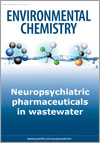EN15202Neuropsychiatric pharmaceuticals and illicit drugs in wastewater treatment plants: a review
Environmental context. Neuropsychiatric pharmaceuticals and illicit drugs in wastewaters are of increasing environmental concern. We compile the recent literature and evaluate the concentrations and profiles of various drugs and their removal efficiencies in wastewater treatment plants. The sewage epidemiology approach, used in the estimation of drug usage in communities, is discussed, and we make recommendations for future research in this area.




